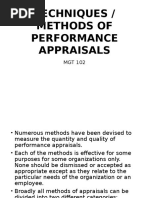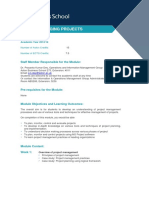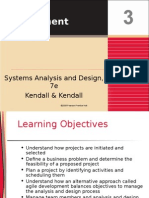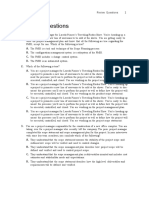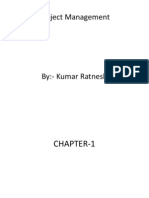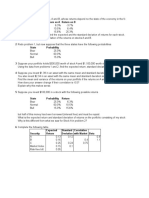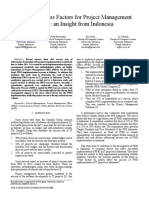Project Selection Methods
Uploaded by
osama_ahProject Selection Methods
Uploaded by
osama_ahTwo General Types of Project-Selection Methods
The two methods of project selection are benefit measurement (comparative approach) and
constrained optimization (mathematical approach). Table 3.1 summarizes the key points of these two
method types.
CAUTION
The exam will require you to know the methods of project selection, their main differences, and
examples of each.
Table 3.1 Project-Selection Methods
Method
Type
Examples
Notes
Benefit
measuremen
t
(comparative
approach)
Scoring
models,
cost-benefit
analysis,
review
board,
economic
models.
Benefit
measurement
is the most
common
approach.
Constrained
optimization
(mathematic
al approach)
Linear
programmin
g, nonlinear
programmin
g, integer
programmin
g, dynamic
programmin
g, multiobjective
programmin
Constrained
optimization
makes use of
math models
and complex
criteria and is
often
managed as
a distinct
project
g.
phase.
You might also like
- Success Factors of Management ConsultingNo ratings yetSuccess Factors of Management Consulting34 pages
- Final Essay - Organizational Behavior and Reflecting On BoeingNo ratings yetFinal Essay - Organizational Behavior and Reflecting On Boeing8 pages
- Salience Model: Stakeholder ClassificationNo ratings yetSalience Model: Stakeholder Classification2 pages
- MBA 624 Fall 2015 Project Analysis SyllabusNo ratings yetMBA 624 Fall 2015 Project Analysis Syllabus7 pages
- Tools and Techniques of Project ManagementNo ratings yetTools and Techniques of Project Management2 pages
- Critical Path Method (CPM) in Project ManagementNo ratings yetCritical Path Method (CPM) in Project Management8 pages
- PROJ MANAGEMENT Team Selection and AcquisitionNo ratings yetPROJ MANAGEMENT Team Selection and Acquisition4 pages
- Bnm808 Managing Projects: Staff Member Responsible For The ModuleNo ratings yetBnm808 Managing Projects: Staff Member Responsible For The Module5 pages
- Information Technology Project Management (UCCD2043)No ratings yetInformation Technology Project Management (UCCD2043)38 pages
- Project Management: Systems Analysis and Design, 7e Kendall & KendallNo ratings yetProject Management: Systems Analysis and Design, 7e Kendall & Kendall50 pages
- PMBOK Chapter 2-3 Project Environment and PM RoleNo ratings yetPMBOK Chapter 2-3 Project Environment and PM Role19 pages
- The Bcs Professional Examinations BCS Level 5 Diploma in IT October 2009 Examiners' Report IT Project Management Section ANo ratings yetThe Bcs Professional Examinations BCS Level 5 Diploma in IT October 2009 Examiners' Report IT Project Management Section A10 pages
- Session 1 - Week 1 - Introduction To Project ManagementNo ratings yetSession 1 - Week 1 - Introduction To Project Management27 pages
- M5 - Organizational Pressures and StructuresNo ratings yetM5 - Organizational Pressures and Structures27 pages
- Project Scope Management: The Project Scope Statement, The WBS and The WBS DictionaryNo ratings yetProject Scope Management: The Project Scope Statement, The WBS and The WBS Dictionary3 pages
- Chapter 1 - Introduction To Project ManagementNo ratings yetChapter 1 - Introduction To Project Management10 pages
- PD5 - Programme and Project Management - Questions and AnswersNo ratings yetPD5 - Programme and Project Management - Questions and Answers10 pages
- Program Evaluation: A Brief Introduction ..No ratings yetProgram Evaluation: A Brief Introduction ..13 pages
- Project Management Office Transformations: Direct and Moderating Effects That Enhance Performance and MaturityNo ratings yetProject Management Office Transformations: Direct and Moderating Effects That Enhance Performance and Maturity27 pages
- Critical Success Factors For Project Management Office - An Insight From IndonesiaNo ratings yetCritical Success Factors For Project Management Office - An Insight From Indonesia6 pages
- Principles of Integrated Project ManagementNo ratings yetPrinciples of Integrated Project Management15 pages
- Unit - Iii: Project Monitoring and ControlNo ratings yetUnit - Iii: Project Monitoring and Control75 pages













